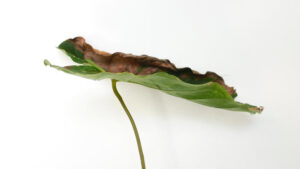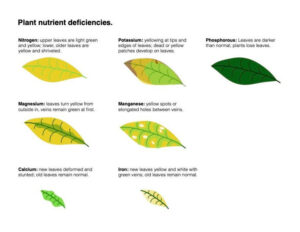OCTOBER 25, 2022

It can be frightening to see your plants leaves looking like this. – Vi Tran / Unsplash
Learn to diagnose a struggling houseplant, no medical degree required.
One of the most frustrating things about plant parenthood is the guesswork. You will, with time, get better at figuring out if your leafy little ones are thirsty, getting too much sun, or just not happy with their location—but not before killing some along the way.
Fortunately, nutrient deficiency is one problem you can interpret a bit more easily if you know how to spot it. If you see a dreaded yellowing or browning leaf, holes, or curling tips, your plant may be victim to the vegetal equivalent of scurvy.
Knowing how to read these signs will allow you to help your plants by providing proper and timely care. But first, you’ll have some diagnosing to do.
Understanding nutrient deficiencies in plants
Just like us, plants need nutrients to carry out functions like growing and reproducing. If they don’t have enough, they may survive, but they won’t thrive. Undernourished plants may face stunted growth, deformation, or reduced chlorophyll production, which explains signs like yellowing and curling leaves.
Primary macronutrients are the nutritional foundation for all plants, and they comprise the famous NPK ratio you’re probably familiar with from reading fertilizer labels: nitrogen, phosphorus, and potassium. Plants tend to use up these nutrients quicker than others, but that doesn’t mean they’re the most important. Secondary macronutrients, and micronutrients, can also cause nutritional deficiencies and are just as vital to your plant’s health.

No need to memorize all the nuances—just save this handy graphic. – Paul CaraDonna / Chicago Botanic Garden
There are many reasons plants become malnourished. They may be using up all the available nutrients in the soil too quickly, or unable to properly absorb nutrients from their roots due to root rot caused by overwatering. In this way, signs of insufficient nutrients can also be a symptom of other issues like improper watering or incorrect soil pH, while also worsening the risk for additional problems, like fungal infections.
Regardless of the cause, nutrient deficiencies can kill your plants, so understanding what some of these look like can help you get your leafy friend out of trouble and back to soaking up sun on your window sill.
Nitrogen deficiency
Because of its status as a primary macronutrient, low levels of nitrogen are common. Luckily, they’re also easy to spot, generally manifesting as yellowing leaves, says Paul CaraDonna, a conservation scientist at the Chicago Botanic Garden.
If you think your plant may need more nitrogen, look at the leaves of your plant’s old growth. A lack of this nutrient can affect the entire plant, but in a deficit, the vascular system will prioritize the health of new growth by diverting nitrogen there, resulting in older leaves becoming yellow first.
As the deficiency progresses, newer growth may become light green and yellow, and older leaves may start to shrivel.
Phosphorus deficiency
Like nitrogen, phosphorus is a mobile nutrient—one that moves throughout the plant—but a key difference is that when levels of this element are low, leaves turn dark.
If your plant’s older leaves begin to turn abnormally dark green or adopt a purple hue, your plant progeny might be craving additional phosphorus.
Potassium deficiency
You’ll often notice the lack of the third primary macronutrient along the edges of leaves, where they’ll appear to be scorched and yellow, a condition known as chlorosis.
Calcium deficiency
Although a lack of this secondary macronutrient might not inhibit your plant’s growth as often as the primary ones, calcium deficiencies can still happen. But calcium is an immobile nutrient, meaning the plant can’t redistribute this element in a last-ditch effort to help younger leaves survive. This results in old leaves looking normal, with the signs of deficiency appearing on young leaves instead. In the case of low calcium levels, new growth may look stunted or deformed, curling inward – kind of like a Shrinky Dink that hasn’t been heated up enough to flatten out.
Magnesium deficiency
Magnesium is another secondary macronutrient, and not having enough of it may cause a plant to start yellowing around the edges of older leaves while the veins remain green. This condition is known as interveinal chlorosis. As the deficiency continues, younger leaves may exhibit these signs, and necrotic brown spots can appear on leaves before they fall off.
Iron deficiency
Plants can be anemic, too. Well, kind of. Iron, like calcium, is an immobile micronutrient, so look to the baby leaves to spot this deficiency. Plants experiencing an iron deficit may exhibit yellowing of these leaves, but their veins will remain visibly green in another case of interveinal chlorosis.
Manganese deficiency
A lack of manganese results in leaves turning yellow while some veins stay green, although they won’t be as clearly outlined as with an iron deficiency. Necrotic brown spots may follow, leading to holes between leaf veins.
No need to memorize all the nuances—just save this handy graphic. How to fix nutrient deficiencies in plants
It’s easy to become overwhelmed by all of the factors that play a role in your plants’ nutrient uptake. Other rarer deficiencies muddy the waters even more, displaying remarkably similar cues on foliage. A molybdenum deficiency, for example, can look a lot like a lack of nitrogen.
“There’s a reason farmers pay people to figure out what their crops are deficient in,” says CaraDonna.
In other words, figuring out which deficiency you’re dealing with can be hard if you’re not an expert. But that doesn’t mean you can’t help your plants at all.
Once you realize your plant needs help, work step by step. It’s important not to try to fix every possible issue at once, as you’ll risk choosing the wrong treatment. Instead, try isolating your variables and start with the basics. First, try replacing the soil. If that doesn’t change anything after a few weeks, change your watering routine. And if that doesn’t make things better, move the plant to different lighting.
If your undernourished plant lives in a pot, CaraDonna explains, it’s easy for it to go through the available resources, aka nutrients, quickly. The fix may be as easy as repotting your plants into fresh, nutrient-rich soil, or you can supplement the nutrients in the pot with a general fertilizer that can address multiple common macronutrient deficiencies.
And because plants run out of these more frequently than micronutrients, generally treating for nitrogen, phosphorus, and potassium deficiencies might be enough to get your plant on the right track. It’s not worth it to stress about providing micronutrients, CaraDonna says, unless you have “a really old plant that’s really special to you.”
But if a general treatment isn’t helping your plant go back to its former glory, you can try fertilizers made for specific plants. For example, there are fertilizers made especially for citrus plants, and they should be available at your local home goods store. Doing some research to get to know what your greenery needs is also helpful. Every plant has an optimal level of nutrients, and it differs depending on the species and their native soil pH. So knowing, for example, that your plant naturally grows in acidic soil and might not need much nitrogen, but would enjoy a small sip of iron, can be helpful.
And don’t forget that even if you’re dealing with a nutrient deficiency, it’s possible that the remedy is not about providing more fertilizer but regulating your plant’s water intake instead.
“The No. 1 killer of houseplants is probably overwatering and then underwatering,” says CaraDonna. “Water allows for a plant to suck up nutrients, [but] It can’t suck up anything from dry soil.”
Build a relationship with your plants
Admittedly, there are a lot of factors to consider that might be making your plant have yellow leaves or not be getting the right nutrients. CaraDonna has some advice: name your plants.
“At my house, all the plants have names. My daughter said, ‘Oh, Bruno has some yellow leaves.’ And her relationship with the plant is what alerted me to the issue that Bruno has a little bit of a nitrogen deficiency. It’s about knowing your plants and being in touch with them.”
Sure, you don’t actually have to name your plants, but the point is that forming a relationship with them will help you be more in tune with their needs and, in turn, pay closer attention when something is off.
Patience is key
No matter what kind of deficiency your plant has, remember the ultimate plant-caring tip: Be patient.
CaraDonna suggests taking before and after pictures a couple of weeks apart for every change you make, be that regulating water or lighting, changing the soil, or adding fertilizer. Only move on to try something new if there’s no visible change (or the change is for the worse).
Patience truly is a virtue, so don’t give up hope. “Most houseplants can roll with a lot of punches,” says CaraDonna. So if you see some necrotic spots or interveinal chlorosis, it’s still worth a try.










































































































